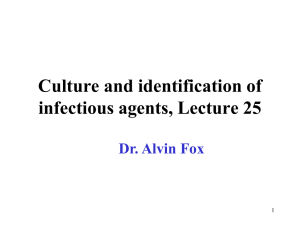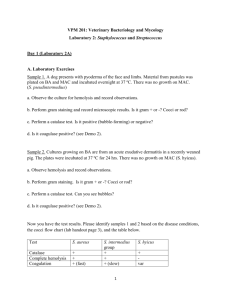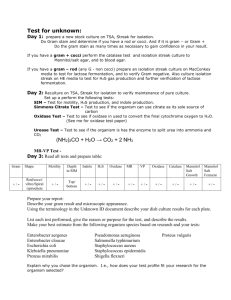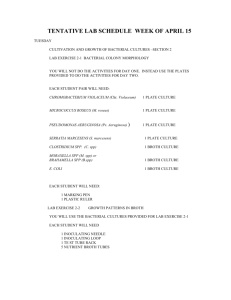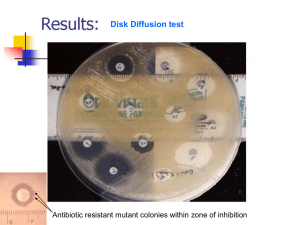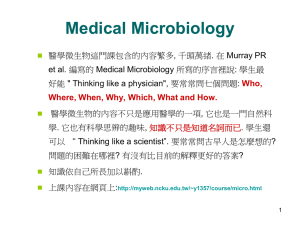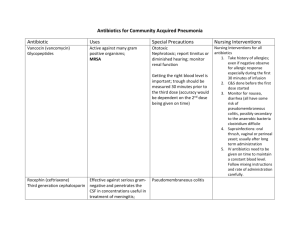Clinical Microbiology
advertisement
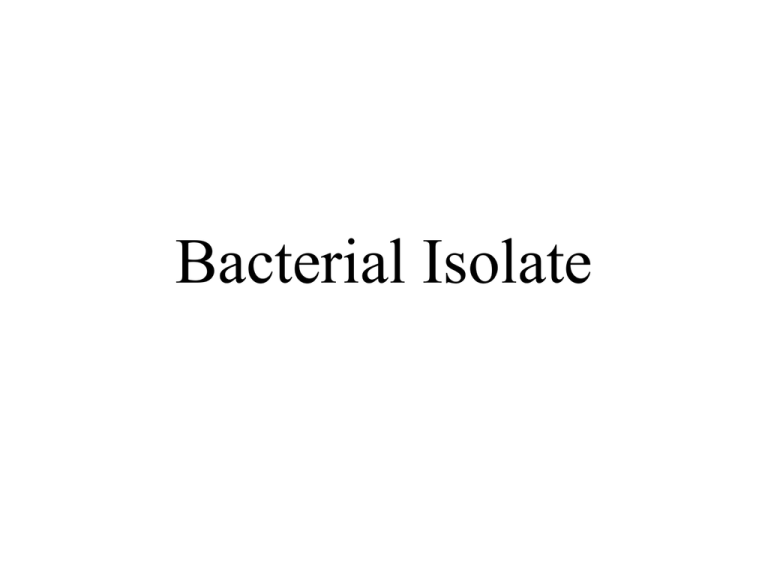
Bacterial Isolate Gram positive rods Possible organisms on the gram stain, L.Monocytogenes, L.Ivanovii, Corynebacterium sp. Listeria monocytogenes http://parasites.czu.cz/food/parasite.php?idP arasite=59 On SBA L.monocytogenes grow as small, round, smooth, and translucent. Beta hemolysis. Grow in chocolate. Identification tests for the organism include catalase, motility, Esculin hydrolysis, and 6.5% NaCl are positive. If incubated at room Umbrella motility viewed. Disease associated with L.monocytogenes cause food poisoning if contaminated cheese, chicken, ice cream, and hot dogs consumed. In pregnant women it is responsible for spontaneous abortion and stillborn neonates. Infection of the neonates is extremely serious and fatality rate is about 50% for newborn. Gram positive cocci in pairs Possible organisms on gram stain under microscope, S.Pneumoniae, S.Bovis, S.mitans Streptococcus pneumoniae On SBA the colony appearance is dark alpha hemolytic, mucoid appearance, dime shape, and translucent colony. Identification test is Catalase-negative, Optichin disk-positive, bile solubile and quellung reaction is positive. Disease associated are Pneumonia, sinusitis, bacterial, meningitis, otitis media, and arthritis. Most frequently isolate in children under age of 3years with recurrent otitis media and the number one cause of bacterial pneumonia in elderly persons and in patients with underlying disease. http://textbookofbacteriology.net/S.pneum oniae.html Gram positive Cocci in clusters Possible organisms on the gram stain, S.Aureus,S. Saprophyticus S.epidermitis S. aureus On SBA it is beta hemolytic, creamy, buttery looking colony. Identification tests include Catalase and Coagulase tests both of which are positive for this organism. Diseases caused by S. aureus include cutaneous infections like folliculiti ,carbuncles, impetigo and toxic induced diseases such as food poisoning, scalded skin syndrome, and toxic shock syndrome. Gram positive Cocci in chains Possible organisms on gram stain under microscope, S.Pyogenes, S.Agalactiae, Entercoccus spp. Streptococuss pyogenes On SBA S.pyogenes grow as small, transparent, smooth and beta hemolysis. Identification test for the organism is Catalasenegative. Bacitrain and PYR are sensitive and positive. Common disease associated are pharyngitis is the most common, impetigo, erysiples, cellulites, scarlet fever, rheumatic fever, acute glomerulonephritis, streptococcal TSS, and necrotizing fasciitis. http://www.bakteriologieatlas.de/Bakt erien/Streptococcus_pyogenes.htm Gram Negative Rod Possible organisms on gram stain under microscope, E.Coli, K.Pnemoniae, C.freundii Escherichia coli On SBA some are beta hemolysis and some non hemolysis. Large and gray colony. Some ferment lactose. Identification tests include Oxidase is Positive and the tubes test, TSI-A/A without H2S production. LIA is Neg/Pos. Most of E.coli are motile and all are Indole positive. Citerate is Negative for this test. Disease associated with the presence of this organism such as GI tract pathogens like Enteropathogenic, enterotoxigenic, enteroinvasive, enterohemorragic, and HUS are common infection in GI. UT Infection is mostly caused by this organism. Septicemia and Meningitis are also caused by E.coli.


